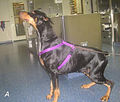Wobbler disease
Wobbler disease is a neurological disorder that affects the spinal cord and is seen in certain breeds of dogs. It is also known as cervical spondylomyelopathy (CSM), or more commonly, wobbler syndrome.
Overview[edit]
Wobbler disease is characterized by a "wobbly" gait, hence the name, which is caused by compression of the spinal cord and associated nerves. This compression can be due to a variety of factors, including vertebral malformation, disc disease, and spinal cord injury. The disease primarily affects large and giant breed dogs, such as the Doberman Pinscher and the Great Dane, although it can occur in smaller breeds as well.
Symptoms[edit]
The symptoms of wobbler disease can vary depending on the severity of the spinal cord compression. However, common symptoms include:
- Neck pain
- Difficulty walking or a wobbly gait
- Weakness in the hind legs
- Difficulty getting up from a lying or sitting position
Diagnosis[edit]
Diagnosis of wobbler disease is typically made through a combination of clinical signs, medical history, and diagnostic imaging such as radiographs, computed tomography (CT), and magnetic resonance imaging (MRI).
Treatment[edit]
Treatment for wobbler disease can be either surgical or non-surgical. Non-surgical treatment typically involves the use of medications to reduce inflammation and pain, along with physical therapy. Surgical treatment involves decompressing the spinal cord and may be recommended in severe cases or when non-surgical treatment is not effective.
Prognosis[edit]
The prognosis for dogs with wobbler disease varies depending on the severity of the disease and the treatment chosen. Some dogs may improve with treatment, while others may continue to deteriorate.
See also[edit]
Ad. Transform your life with W8MD's Budget GLP-1 injections from $75


W8MD offers a medical weight loss program to lose weight in Philadelphia. Our physician-supervised medical weight loss provides:
- Weight loss injections in NYC (generic and brand names):
- Zepbound / Mounjaro, Wegovy / Ozempic, Saxenda
- Most insurances accepted or discounted self-pay rates. We will obtain insurance prior authorizations if needed.
- Generic GLP1 weight loss injections from $75 for the starting dose.
- Also offer prescription weight loss medications including Phentermine, Qsymia, Diethylpropion, Contrave etc.
NYC weight loss doctor appointmentsNYC weight loss doctor appointments
Start your NYC weight loss journey today at our NYC medical weight loss and Philadelphia medical weight loss clinics.
- Call 718-946-5500 to lose weight in NYC or for medical weight loss in Philadelphia 215-676-2334.
- Tags:NYC medical weight loss, Philadelphia lose weight Zepbound NYC, Budget GLP1 weight loss injections, Wegovy Philadelphia, Wegovy NYC, Philadelphia medical weight loss, Brookly weight loss and Wegovy NYC
|
WikiMD's Wellness Encyclopedia |
| Let Food Be Thy Medicine Medicine Thy Food - Hippocrates |
Medical Disclaimer: WikiMD is not a substitute for professional medical advice. The information on WikiMD is provided as an information resource only, may be incorrect, outdated or misleading, and is not to be used or relied on for any diagnostic or treatment purposes. Please consult your health care provider before making any healthcare decisions or for guidance about a specific medical condition. WikiMD expressly disclaims responsibility, and shall have no liability, for any damages, loss, injury, or liability whatsoever suffered as a result of your reliance on the information contained in this site. By visiting this site you agree to the foregoing terms and conditions, which may from time to time be changed or supplemented by WikiMD. If you do not agree to the foregoing terms and conditions, you should not enter or use this site. See full disclaimer.
Credits:Most images are courtesy of Wikimedia commons, and templates, categories Wikipedia, licensed under CC BY SA or similar.
Translate this page: - East Asian
中文,
日本,
한국어,
South Asian
हिन्दी,
தமிழ்,
తెలుగు,
Urdu,
ಕನ್ನಡ,
Southeast Asian
Indonesian,
Vietnamese,
Thai,
မြန်မာဘာသာ,
বাংলা
European
español,
Deutsch,
français,
Greek,
português do Brasil,
polski,
română,
русский,
Nederlands,
norsk,
svenska,
suomi,
Italian
Middle Eastern & African
عربى,
Turkish,
Persian,
Hebrew,
Afrikaans,
isiZulu,
Kiswahili,
Other
Bulgarian,
Hungarian,
Czech,
Swedish,
മലയാളം,
मराठी,
ਪੰਜਾਬੀ,
ગુજરાતી,
Portuguese,
Ukrainian







